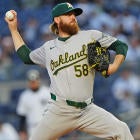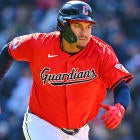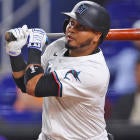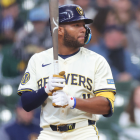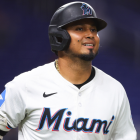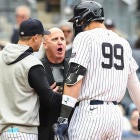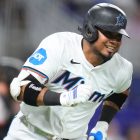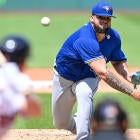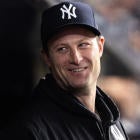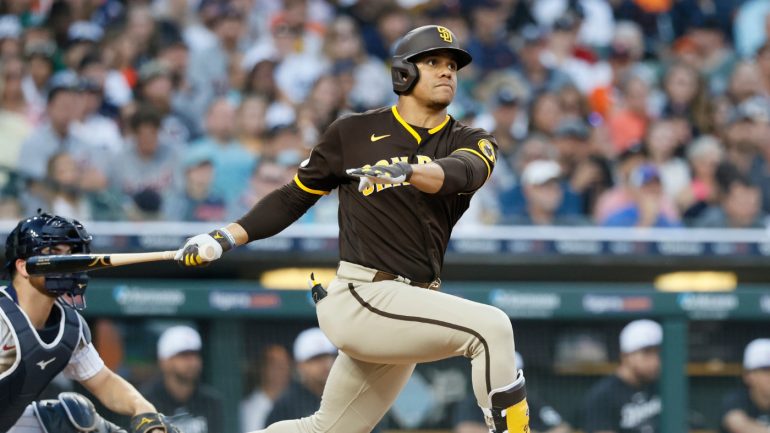
Believe it or not, it's been almost a year since the San Diego Padres and Washington Nationals agreed to an eight-player trade headlined by Juan Soto. That was, without rival, the biggest deal of Major League Baseball's 2022 trade deadline. With both the year mark and the 2023 deadline approaching, we felt this would be an appropriate time to revisit and reexamine the Soto trade.
You can find our original in-depth analysis of the trade by clicking here. We loved the deal for the Padres, observing that they had landed an elite young hitter for up to three playoff runs without compromising the rest of their big-league roster. We were not as sweet on the Nationals' side -- and not because of the players involved. Rather, we wrote: "The reality is that you've already lost if you find yourself trading a 23-year-old on a Hall-of-Fame track who has several more years of team control remaining."
Below, we've checked in on all the involved parties and issued an updated verdict on how the trade is looking nearly 365 days later. (Do note that the statistics in this article are as of Friday, July 28.)
Here, as a reminder, were the particulars of the trade:
Padres receive
- OF Juan Soto
- 1B Josh Bell
Nationals receive
- 1B Luke Voit
- SS C.J. Abrams
- LHP MacKenzie Gore
- OF Robert Hassell III
- OF James Wood
- RHP Jarlin Susana
We'll begin by addressing the two players no longer with either club before moving on to the Nationals' return and then Soto himself.
Departed first basemen
Bell has become an afterthought in this trade for various reasons. At the time, though, his inclusion seemed like a big deal given that he'd hit .301/.384/.493 with 14 home runs in 103 games prior to the swap.
Bell's breakout season turned sour upon arriving in San Diego. He'd bat just .192/.316/.271 with three home runs over the course of 53 contests. That stretch dropped his seasonal OPS from .877 down to .784. As a free agent, Bell signed a two-year contract worth $33 million with the Cleveland Guardians. While the pact affords him the right to opt out this winter, it seems unlikely that he will.
You may recall that Voit was not rumored to be part of the trade's original framework. Instead, Eric Hosmer's name was bandied about, but he exercised his no-trade clause to stay put for the time being (he was later shipped to the Boston Red Sox).
Voit appeared in 53 games for the Nationals, hitting .228/.295/.381 with nine home runs. The Nationals declined to tender him a contract at the beginning of last winter, making him a free agent despite his remaining two seasons of team control. Washington signed a different non-tendered first baseman, Dominic Smith, and he's since outhit Voit, who eventually resurfaced as a member of the Milwaukee Brewers and is now playing for the Mets' Triple-A team.
It's fair to write that the final accounting of this trade will not bother much with what either Bell or Voit did during the final months of the 2022 campaign. Let's shift to the players of greater (i.e. any) significance.
The Nationals side
In total, the Nationals received six players back for Soto and Bell. Let's work our way down the depth chart, beginning with the two players who are currently on Washington's big-league roster.
Gore, the No. 3 pick in the 2017 draft, happened to be on the injured list with a sore elbow when the trade occurred. That represented an upgrade over where he had been a year prior, battling the yips and facing an uncertain road ahead. He returned to make four minor-league appearances afterward, but he didn't record his first real outing with the Nationals until this season. In 20 starts, he's amassed a 4.37 ERA (96 ERA+) and a 2.84 strikeout-to-walk ratio.
Gore, 24, has demonstrated that he can miss bats and coerce chases outside of the strike zone with what amounts to a three-pitch arsenal. He has a 95 mph rising fastball that plays quicker than that thanks to a deep release point. He also deploys his signature curveball, a pitch that has previously elicited comparisons to Los Angeles Dodgers lefty Clayton Kershaw, and a gyro slider.
The ingredients for a mid-rotation starter or better are present. Gore, however, has continued to battle his command. He's walked roughly 10% of the batters he's faced this season (fifth-highest among qualified starters), and his sloppy geography has resulted in too much loud contact: 46% of the batted balls he's surrendered have been clocked with exit velocities over 95 mph, as compared to the league-average rate (among qualifiers) of 40%. He'll need to find a way to improve in that respect to live up to his full promise.
Abrams, 22, has hit .257/.307/.424 (103 OPS+) with 10 home runs and 21 stolen bases over his first 94 games this season. Those marks are respectable on their own, and encouraging considering his greater career context. Remember, Abrams missed significant developmental time because of injury and the pandemic before the Padres rushed him to the majors to debut at age 21. That he's holding his own at the game's highest level should be viewed as a positive sign since it bodes well for what he could do in a few years' time.
Make no mistake, Abrams still has aspects to improve upon if he's going to become a top contributor. At the plate, he needs to work on his swing decisions -- not just expanding his strike zone, but keying in on what pitches he can do the most damage on. As it is, he's far too willing to swing at pitches up and in despite not feasting on them. The other looming question with Abrams is his long-term defensive home. He has average arm strength, but that hasn't stopped him from making nine throwing errors (of 14 overall). Statcast's Outs Above Average metric has Abrams ranked in the 2nd percentile. Not great.
Again, it's worth giving Abrams a wider berth than the average second-year infielder. If the Nationals can help him shore up those aspects of his game, they could have something special here. At minimum, the competency he's displayed this season should serve as a baseline of sorts.
Wood, who won't celebrate his 21st birthday until September, still has the best chance of serving as the crown jewel of the deal for the Nationals. He's made a quick ascent on prospect lists since being selected with the 62nd pick in the 2021 draft; some industry sources even considered him to be the top prospect in baseball entering the spring. (We placed him seventh in our latest rankings.) Even so, he's experienced his first sustained patch of turbulence since being promoted to Double-A, striking out in more than 31% of his trips to the plate.
Wood offers a tantalizing amount of power and athleticism. He also has a keen eye that should boost his on-base percentage. The concern with him dating back to his amateur days was that his large frame (he's listed at 6-foot-6) could make him exploitable at the plate and overly prone to strikeouts. To Wood's credit, he had kept his K rate in check prior to reaching Double-A. It's now on him to make the necessary adjustments to get his strikeout percentage back on the sunny side of 30%. If he can do that, his secondary skills and ability to stick in center field will provide him with an all-star-caliber upside.
Hassell, the No. 8 pick in the 2020 draft, is nearing his 22nd birthday. It would be premature to write him off as a lost cause, but it is fair to acknowledge that his game isn't trending in the right direction. We wrote at the time that Hassell needed to be able to either stick in center field or realize his untapped power potential. He's performed so poorly at Double-A that he's rendered the positional concerns moot. Indeed, Hassell's slugging output has been capped by a nearly 55% ground-ball percentage. What's worse is that he's also struck out in roughly 30% of his trips to the plate. That's a rotten combination, and one that threatens to reduce him to a non-entity before he can even debut.
Susana, still only 19, benefitted from a conveniently timed helium boost. Hm. Some of the gas has been released from the balloon this season, as he's failed to keep his walk rate in check. In theory, Susana has a power pitcher's frame and fastball-slider combination; in reality, his heater plays down because of a suboptimal shape, as recently noted by FanGraphs' Eric Longenhagen. We'll see what the future holds for Susana, but you'll usually win if you bet against teenage right-handers turning into above-average big-league starters.
Juan Soto
For our money, the strangest development in the past year has been the narrative that has enveloped Soto's performance. He's hit .253/.407/.463 (148 OPS+) with 26 home runs and more walks than strikeouts in 155 games with the Padres. Those numbers work out to 5.7 Wins Above Replacement, according to Baseball Reference's calculations. That would represent the second-most productive single-season of his career. Yet there's this belief that he's underperformed or otherwise failed to live up to the hype.
If we had to guess, there are a handful of reasons for this perception, beginning with the Padres' disappointing play this year. Beyond that, we think some of it has to do with outdated or ill-informed analysis. It doesn't matter that Soto's batting average with San Diego has far outpaced the league-average despite PETCO Park's reputation, and it doesn't matter that "Moneyball" preached the importance of on-base percentage more than 20 years ago: a certain sect of baseball people see a .253 average and scoff.
Dating back to last season, here's a complete list of players (min. 200 plate appearances) who have reached base at a higher clip than Soto has as a Padre:
- Aaron Judge (.420)
That's it. That's the complete list: the player who won the American League Most Valuable Player Award last season is the only person to make a lower percentage of outs the past two seasons than Soto has as a Padre alone.
Perhaps part of the Soto discourse stems from his power output. He's homered 26 times in 155 games, or once every six games. For his Nationals career, he homered once every 4.7 games. Soto has cleared the 30-homer mark just once so far. He certainly has the top-end raw power to do more damage, but his swing is geared toward hitting hard ground balls and line drives. That hasn't changed, and it's probably unrealistic to have expected it to with the trade.
Why? Because the Padres wanted the same Soto whose most similar batters through his age-23 season were Bryce Harper, Frank Robinson, and Mickey Mantle. Miguel Cabrera and Henry Aaron also rank in his top 10, according to Baseball Reference. Everyone wants to maximize a player's output, but it's safe to leave someone alone when they're 24 and on a Hall-of-Fame track.
With all the above established, we get why people feel this deal hasn't worked out as planned for the Padres. It hasn't fully. Part of the appeal in landing Soto was that he would be a part of three playoff pushes. The Padres appear unlikely to make the postseason this year, and already rumors have surfaced that they're unlikely to sign him to a long-term extension. In turn, that means they could look to trade him this offseason, before he enters his walk year.
One player can do only so much. We think Soto has held up his end of the bargain, and that he shouldn't be blamed for the Padres' greater failures.
The verdict so far
There's a temptation to evaluate past trades through the lens of "would this team do the trade in reverse." In other words, would the Padres trade Soto for the players they shipped to D.C., and would the Nationals send their collection of youngsters to San Diego for Soto? We think that's a flawed model for a very obvious reason: deals like this are often made because teams have different motivations and incentives. They occupy different spots on the win curve.
We prefer to ask: based solely on how the players have performed and developed since, would these teams make the same exact deal? We think, at this point in time, that both teams would answer in the affirmative.
The Padres have received a great deal of production from Soto. It may turn out that they employ him only for one postseason run. That would be disappointing compared to the promise of the original acquisition. It doesn't mean that this trade was a bust, though; it means that some of the other roster-building maneuvers they made (or didn't make) were errors.
The Nationals, meanwhile, were clearly unwilling to extend Soto at whatever his demand was this time last year. There's no reason to think that number has decreased. There is reason, based on how teams value years of control in this day and age, to think the trade packages would've gotten worse.
Realistically, there's an incredible amount of fairway between now and when the final analysis of this trade will be penned. Keep an eye on what the Padres do with Soto moving forward, and how much the Nationals can extract from Gore, Abrams, and Wood in particular. Those developments will dictate just how this trade comes to look in another decade.














